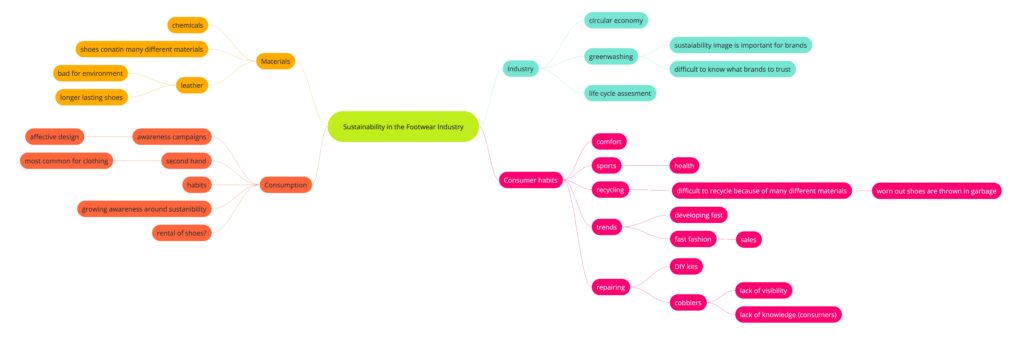In this blogpost I discuss the first two main areas of my mind map and some of the main problems within the areas.

MATERIALS
The big amount of different materials used in shoes are what makes the shoes difficult to recycle, but also difficult to produce sustainably. It can be challenging for consumers to understand what kind of materials they should look for if they want to choose a better option for the environment. It is also important to take in consideration the chemicals used in the production of the shoes. There are instances where vegan leather used in shoe production involves specific toxic chemicals. Even if a product appears to be more environmentally friendly due to the materials used, the overall production process of the shoe may not fulfill the promise of being a greener choice. The effects of the chosen materials must also be compared. While leather is not environmentally friendly, leather shoes tend to have a long lifespan.
Room for improvement: Make it easier for consumers to understand what kind of shoes are more sustainable.

CONSUMPTION
With the growing awareness around sustainability it has become more common to buy second hand clothing, but it is not as common to buy second hand shoes. People might think it is a bit more difficult to buy used shoes because of various reasons. First off, the hygiene aspect is a bit different from used clothing. Some might find it less appealing to buy used shoes then to buy used clothes. Secondly, it might be more difficult to know the condition of used shoes when you can’t speak to the former user and wear and tear might not be immediately visible. Some types of shoes, due to lighter usage, might be easier to buy second-hand than others. Additionally, people might be sceptical beacuse they think that used shoes are already shaped to the previous owner’s feet, which might make them less comfortable for the new owner. There might be a difference between peoples thoughts of buying used shoes from private people through second hand apps for example compared to buying used shoes from a second hand store. When buying from a private seller, you can often get more detailed information about the condition of the shoes and learn more about the previous owner, which can help reduce some concerns.
Room for improvement: Provide more product information about second hand shoes.

🩴 🥿 👠 👡 👢 👞 👟 🥾 🩴 🥿 👠 👡 👢 👞 👟 🥾 🩴 🥿 👠 👡 👢 👞 👟 🥾 🩴 🥿 👠 👡 👢 👞
